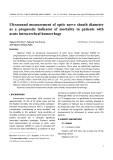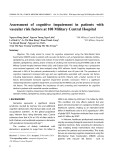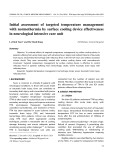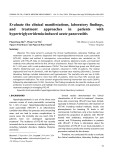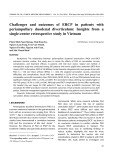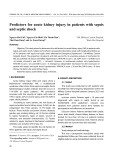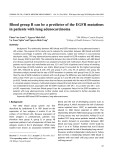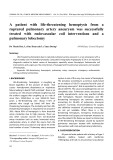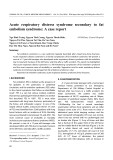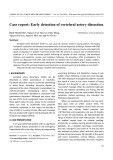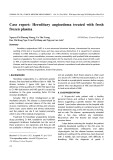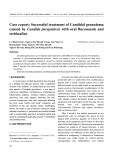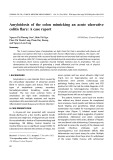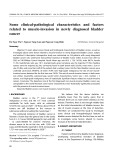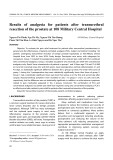The role of N-glycosylation in the stability, trafficking and GABA-uptake of GABA-transporter 1
Terminal N-glycans facilitate efficient GABA-uptake activity of the GABA transporter Guoqiang Cai1,2, Petrus S. Salonikidis3, Jian Fei1, Wolfgang Schwarz3, Ralf Schu¨ lein4, Werner Reutter2 and Hua Fan2
1 Institute of Biochemistry and Cell Biology, SIBS, CAS, Shanghai, China 2 Institut fu¨ r Molekularbiologie und Biochemie, CBF, Charite´ Universita¨ tsmedizin Berlin, Berlin-Dahlem, Germany 3 Max-Planck Institut fu¨ r Biophysik, Frankfurt, Germany 4 Forschungsinstitut fu¨ r Molekulare Pharmakologie, Berlin-Buch, Germany
Keywords GABA transporter; N-glycosylation; N-glycan trimming; membrane trafficking; patch- clamp
Correspondence H. Fan, Institut fu¨ r Molekularbiologie und Biochemie, Campus Bejamin Franklin, Charite´ Universita¨ tsmedicin Berlin, Arnimallee 22, D-14195 Berlin-Dahlem, Germany Fax: +49 30 84451541 Tel: +49 30 84451544 E-mail: hua.fan@charite.de
(Received 17 July 2004, revised 24 January 2005, accepted 2 February 2005)
doi:10.1111/j.1742-4658.2005.04595.x
Neurotransmitter transporters play a major role in achieving low concen- trations of their respective transmitter in the synaptic cleft. The GABA transporter GAT1 belongs to the family of Na+- and Cl–-coupled trans- port proteins which possess 12 putative transmembrane domains and three N-glycosylation sites in the extracellular loop between transmembrane domain 3 and 4. To study the significance of N-glycosylation, green fluor- escence protein (GFP)-tagged wild type GAT1 (NNN) and N-glycosylation defective mutants (DDQ, DGN, DDN and DDG) were expressed in CHO cells. Compared with the wild type, all N-glycosylation mutants showed strongly reduced protein stability and trafficking to the plasma membrane, which however were not affected by 1-deoxymannojirimycin (dMM). This indicates that N-glycosylation, but not terminal trimming of the N-glycans is involved in the attainment of a correctly folded and stable conformation of GAT1. All N-glycosylation mutants were expressed on the plasma mem- brane, but they displayed markedly reduced GABA-uptake activity. Also, inhibition of oligosaccharide processing by dMM led to reduction of this activity. Further experiments showed that both N-glycosylation mutations and dMM reduced the Vmax value, while not increasing the Km value for GABA uptake. Electrical measurements revealed that the reduced transport activity can be partially attributed to a reduced apparent affinity for extra- cellular Na+ and slowed kinetics of the transport cycle. This indicates that N-glycans, in particular their terminal trimming, are important for the GABA-uptake activity of GAT1. They play a regulatory role in the GABA translocation by affecting the affinity and the reaction steps associated with the sodium ion binding.
the transporter
Abbreviations CHO, Chinese hamster ovary; dMM, 1-deoxymannojirimycin; ER, endoplasmic reticulum; FACS, fluorescence activated cell sorting; GABA, c-aminobutyric acid; GAT1, GABA transporter type I; GFP, green fluorescence protein.
FEBS Journal 272 (2005) 1625–1638 ª 2005 FEBS
1625
is function of main physiological believed to be the control of the concentration and dwell time of GABA in the synaptic cleft. Because the transport of one molecule of GABA is coupled to the The cellular membrane transporter for the inhibitory neurotransmitter c-aminobutyric acid (GABA) belongs to a family of secondary active systems that are driven by electrochemica1 gradients of Na+ and Cl– [1]. The
G. Cai et al.
Role of N-glycosylation and N-glycan trimming of GAT1
tagged wild type GAT1 (NNN) and four glycosylation mutants (DDQ, DGN, DDN, and DND) were stably expressed in CHO cells lacking endogenous GAT1. The influence of N-glycosylation mutations and inhibi- tion of N-glycosylation processing on biochemical properties and function were investigated.
cotransport of two Na+ ions and one Cl– ion [2–4], the translocation across the membrane is associated with a current that can be measured by voltage clamp- ing. In the absence of GABA the transport cycle is not completed, but transient charge movements can be detected that reflect partial reactions associated with extracellular Na+ binding and hence provide kinetic information about the transport cycle [5–7].
extracellular between loop
Four subtypes of GABA transporters (GAT1–4) have been found so far [8,9]. GABA transporter type 1 (GAT1) is a single polypeptide of about 67 kDa with 12 putative transmembrane domains. Both N- and C-termini are located in the cytoplasm. The large transmembrane domains 3 and 4 contains three conserved N-glyco- sylation sites (Asn176, Asn181 and Asn184). It has been demonstrated that all three N-glycosylation sites are used in vivo and that no additional sites are pre- sent [10].
transporters In this work, we demonstrated that defective N-gly- cosylation resulted in reduction of the stability and a decrease in the cell surface expression of this protein. The GAT1 mutants containing two N-glycosylation mutations showed a delayed intracellular translocation, but they targeted to the plasma membrane and showed reduced GAT1-specific GABA-uptake activity. If all three N-glycosylation sites were eliminated, a decreased percentage of DDQ mutants was found on the cell the GABA-uptake activity could surface. However, Inhibition of hardly be detected in this mutant. N-glycosylation processing by 1-deoxymannojirimycin (dMM) affected neither the cell surface expression nor stability of this protein, but it resulted in marked reduc- tion of GABA-uptake activity. This suggests that N-glycans, in particular terminal structures of N-gly- cans, are involved in the GABA-uptake process of GAT1. Finally, we found that deficiency of N-glycosy- lation did not affect the affinity of GAT1 for GABA. The observed reduction of GAT1-specific GABA- uptake due to deficiency of N-glycans was attributed to a reduced apparent affinity for extracellular Na+ ions, resulting in a reduction of the kinetics of the transport cycle.
Results
Expression of GAT1/GFP fusion proteins in CHO cells
cDNAs of GFP tagged wild type (NNN) and mutants DND, DDN, DGN and DDQ were transfected into CHO cells, which do not express endogenous GAT1 and GFP. Stable transfectants were selected by fluores- cence activated cell sorting (FACS). Flow cytometry analysis showed the expression of NNN and the transfected CHO cells mutants on the surface of (Fig. 1A). Fluorescence and immunofluorescence micro- scopy showed that both GFP-fluorescence and anti- GAT1 antibodies can be used to detect the expression of the GAT1 ⁄ GFP fusion protein (NNN) on surface and interior of CHO cells (Fig. 1B,C).
FEBS Journal 272 (2005) 1625–1638 ª 2005 FEBS
1626
N-glycosylation is a major post-translational modi- fication in eukaryotic cells. Recent results suggest that this post-translational modification may influence many of the physicochemical and biological proper- ties of the proteins, such as protein folding, stability, targeting, dynamics and ligand binding, as well as interactions [11–16]. It has cell-matrix and cell–cell been suggested that N-glycosylation is involved in the regulation of the transport activity and surface expression of neurotransmitter [10,17]. the GABA transporter is Functional expression of abolished by tunicamycin, a potent inhibitor of N-glycosylation [18]. Experiments with HeLa trans- fectants showed that removal of one or two glycosy- lation sites by site-directed mutagenesis had little effect on the expression of GABA-uptake activity. However, removal of all three N-glycosylation sites resulted in a reduction of GABA-uptake activity [10]. Although such experiments indicate that N-glycosyla- tion mutations lead to a reduction of GABA-uptake activity, we do not know how the N-linked oligosac- charide side chains influence the function of this trans- porter. Liu et al. demonstrated in Xenopus oocytes that mutations of two of the three N-glycosylation sites led to a reduction in turnover rates and complex changes in the interaction of external Na+ with the transport protein as measured by voltage clamping [7]. However, the question remained as to whether the reduction in function of the mutants was due to a change in the biochemical properties of this transpor- ter or to a reduction in the number of GABA trans- porters per cell. In order to clarify the functional significance of N-glycosylation and N-linked oligosac- charides in GAT1, green fluorescence protein (GFP)- The expression of NNN was determined by West- ern blotting with either anti-GAT1 pAb (Fig. 2A) or anti-GFP mAb (Fig. 2B) following immunoprecipita- tion with anti-GFP pAb. This GAT1 ⁄ GFP fusion two protein showed several bands in SDS ⁄ PAGE,
G. Cai et al.
Role of N-glycosylation and N-glycan trimming of GAT1
Fig. 2. Protein expression and N-glycosylation processing of GFP- tagged GAT1 in CHO cells. NNN stable transfected CHO cells were incubated with and without dMM (1 mM) for 72 h. The solubilized protein of transfected cells (1 · 107) was subjected to immunopre- cipitation with anti-GFP Igs. Aliquots of each immunoprecipitate were treated either with Endo H or PNGase F. The resulting mix- ture and the other aliquots of the immunoprecipitate were analyzed by SDS ⁄ PAGE (7.5%) and immunoblotting with anti-GAT1 pAb (A) or anti-GFP mAb (B, C).
Fig. 1. Flow cytometry, fluorescence microscopy and immunofluo- rescence microscopy of GFP-tagged GAT1 in transfected CHO cells. (A) Flow cytometry of GFP-tagged GAT1 wild type and mutants. The polyclonal anti-GAT1 IgG was used for immunostain- ing. Visualization was performed with R-phycoerythrin-conjugated goat anti-(rabbit IgG) Ig. NNN, GFP-tagged wild type GAT1. DND, DDN, DGN and DDQ, GFP-tagged N-glycosylation mutants. (B) Fluorescence microscopy of NNN. The fluorescence of GFP in GFP ⁄ GAT-fusion protein (NNN) was detected. (C) Immunofluores- cence microscopy of NNN. Anti-GAT1 polyclonal antibodies were used for immunostaining after cell fixation and permeabilization. Visualization was performed with R-phycoerythrin-conjugated goat anti-(rabbit IgG) Ig.
lanes 4 and 5),
FEBS Journal 272 (2005) 1625–1638 ª 2005 FEBS
1627
monomeric forms running as a main band of about 108 kDa and a small band of about 96 kDa. The 108 kDa polypeptide was resistant to Endo H diges- tion, while the 96 kDa polypeptide was converted into a polypeptide of 90 kDa after digestion with Endo H (Fig. 2B). Digestion of both monomeric forms with PNGase F resulted in a single 90 kDa N-glycan-free peptide (Fig. 2C, lane 2). This indicates that the 108 kDa peptide contains mature N-glycans of the complex type, while the 96 kDa peptide con- tains only N-glycans of the mannosidic type. The 210 kDa band may represent a dimeric form or a protein aggregate. In addition, inhibition of N-glyco- sylation processing of NNN by 1-deoxymannojirimy- cin (dMM) leads to the reduction of NNN molecule mass to 96 kDa (Fig. 2C, lanes 3 and 6). After diges- tion with either PNGase F or Endo H, this 96 kDa polypeptide was converted to a 90 kDa N-glycan-free polypeptide (Fig. 2C, indicating that the 96 kDa polypeptide contains only N-glycans of oligomannosidic type.
G. Cai et al.
Role of N-glycosylation and N-glycan trimming of GAT1
Expression of N-glycosylation mutants on the plasma membrane of CHO cells
The expression of NNN and N-glycosylation mutants DGN, DDN, DND and DDQ on the plasma membrane of CHO cells was investigated. As shown in Fig. 3A, N-glycosylation mutants exhibited a reduced molecular mass in comparison to that of the wild type NNN. Nevertheless, all N-glycosylation mutants, as well as the wild type NNN, were expressed on the plasma mem- brane. Although all three N-glycosylation sites are absent in DDQ, this mutant was also detected on the plasma membrane of CHO cells, suggesting that N-gly- cosylation or N-linked oligosaccharides are important, but not essential for the translocation of GAT1 to the cell surface. All intracellular proteins of wild type as well as mutants (with the exception of DDQ) gave two bands, while plasma membrane proteins gave only one large band (Fig. 3A). On the basis of the Endo H diges- tion (Fig. 2B,C), the large band is assigned to proteins with N-glycans of mature complex type and the small band to the proteins with N-glycans of mannose-rich type. All bands of the mutants had reduced molecular mass, compared with that of wild type NNN. The reduced molecular masses of mutants are compatible with the absence of N-glycans at the two eliminated N-glycosylation sites, suggesting that the mutants in the cell interior contain N-glycans of both mannosidic and complex types, while those in the plasma membrane contain only N-glycans of the mature complex type.
The relative levels of surface vs. intracellular GAT1 and mutants in a steady expression state were quanti- fied. The distributions between cell surface and cell interior of the mutants DGN, DND and DDN were not significantly different from that of wild type NNN. About 46 ± 4.7% is found on the cell surface. How- ever, the percentage of the cell surface expression in mutant DDQ which lacks all three N-glycosylation sites was only 30 ± 4.4% in the steady expressed state (Fig. 3B).
Fig. 3. Determination of expression of GFP-tagged GAT1 mutants on the surface of transfected CHO cells and measurement of GABA-uptake by GFP-tagged GAT1 wild type and mutants in trans- fected CHO cells. (A) Cell surface and intracellular expression of GFP-tagged GAT1 wild type (NNN) and mutants (DGN, DND, DDN, and DDQ) were analyzed by biotin labelling and Western blotting. Anti-GAT1 serum or anti-GFP mAb MAB2510 were used for immu- nostaining. I, intracellular expression; M, plasma membrane expres- sion. (B) The protein bands obtained in western blotting were analyzed by phosphoimager scanning. Each value represents the mean ± SEM of three separate experiments. The total protein of the cell surface and intracellular bands of each wild type or mutant were set at 100%. (C) Measurement of GABA-uptake by GFP- tagged GAT1 wild type and mutants in transfected CHO cells. The measured GABA-uptake activity was normalized to the amount of GAT1 or mutant protein expressed on the plasma membrane. The activity of GABA-uptake by NNN was set at 100%. All other values were expressed relative to this value. The values represent the mean ± SEM of four separate experiments.
N-Glycosylation mutations result in reduction of GABA-uptake activity
FEBS Journal 272 (2005) 1625–1638 ª 2005 FEBS
1628
mutants were reduced significantly. Figure 3C shows that the GABA-uptake activities of mutants with double N-glycosylation mutations, DND, DGN and For quantitative measurement of the specific activity of GABA-uptake, an aliquot of the stable CHO trans- fectants was used for the GABA-uptake assay, and another aliquot was used to determine the amount of the membrane-expressed wild type or mutant proteins. The GABA-uptake activities were normalized to the same amount of cell surface proteins of wild type and mutants. Compared with that of the wild type, the the N-glycosylation GABA-uptake activities of
G. Cai et al.
Role of N-glycosylation and N-glycan trimming of GAT1
reduced specific activities of the
DDN, were reduced to 64% (±5.6%), 42% (±12.4%) and 32% (±8.2%) of that of NNN, respectively. GAT1-mediated transport could hardly be detected in the mutant DDQ, although this mutant was expressed on the plasma membrane. Mutant DDQ does not exhi- bit any N-glycosylation site. Because all values were normalized to the transporter proteins in the plasma membrane, the mutants are not due to a reduced number of GABA transporters per cell, but to a reduced transport rate. This suggests that N-linked oligosaccharide side-chains are important for the GABA transport activity.
1-Deoxymannojirimycin inhibits the GABA-uptake of GAT1
treatment with dMM (1 mm) for 72 h,
Influence of dMM on plasma membrane trafficking and Fig. 4. GABA-uptake of GFP-tagged GAT1 wild type. NNN stable trans- fected CHO cells were incubated with and without dMM (1 mM) for 72 h. (A) Aliquots of cells were used for membrane biotinyla- tion. After solubilization, 300 lg total proteins of cell lysates were precipitated with streptavidin beads. The eluates were analyzed by Western blotting using anti-GFP mAb. (B) Another aliquot of cells was used for measurement of GABA-uptake as described above. The values represent the mean ± SEM of three separate experi- ments.
In order to gain further insight into the role of the terminal structures of the N-glycans of GAT1, N-gly- cosylation processing of NNN was inhibited by 1-de- oxymannojirimycin (dMM). Inhibition by dMM leads to the formation of NNN molecules containing N-gly- cans of oligomannosidic type. Figure 4A shows that after the amount of plasma membrane NNN containing man- nosidic N-glycans was in the same range as that of NNN containing mature complex N-glycans without treatment with dMM. However, the activity of GABA- uptake was reduced to 37% after treatment with dMM (Fig. 4B). This indicates that the terminal trimming of N-oligosaccharides is not involved in the regulation of plasma membrane trafficking of GAT1, but in the regulation of GABA uptake.
As well as wild type, mutant DND, DGN and DDN exhibited only one small band on SDS ⁄ PAGE after treatment with dMM (data not shown), indica- ting that, like wild type, they contain only mannosidic N-glycans. The level of cell surface expression was sim- ilar with and without dMM treatment for both wild type and mutants (Figs 4A and 5A). However, their GABA-uptake activity was reduced to half after treat- ment with dMM (1 mm) for 48 h (Fig. 5B). Although mutant DND, DGN and DDN contain only one N-glycosylation site, deficiency of terminal trimming of their N-oligosaccharides strongly affected their GABA- the terminal uptake activity. These indicate that structure of facilitate efficient the oligosaccharides GABA-uptake activity of the GABA transporter.
Defective N-glycosylation results in reduction of the stability of GAT1
FEBS Journal 272 (2005) 1625–1638 ª 2005 FEBS
1629
intracellular decay time of the GAT1, GAT1 treated with dMM, and the mutants was determined by pulse- chase experiments (Fig. 6). Figure 6B shows that wild type NNN was very stable with an exponential half-life of about 22 h, whereas the half-life of mutant DDN containing two N-glycosylation mutations was reduced to 12 h. The half-life of DDQ containing all three N-glycosylation mutations was reduced even more, compared with that of DDN, showing a value of only 5.5 h. In contrast, the stability of NNN containing only mannosidic N-glycans after treatment with dMM In order to study the influence of the N-glycosylation and N-linked oligosaccharides on protein stability, the
G. Cai et al.
Role of N-glycosylation and N-glycan trimming of GAT1
Fig. 5. Analysis of the cell surface expres- sion and GABA-uptake activity of GFP-tag- ged GAT1 wild type and mutants after treatment with dMM. CHO stable transfect- ants were incubated with and without dMM (1 mM) for 48 h (A) Cell surface expression by FACS analysis. Anti-GAT IgG was used for the immunostaining. Visualization was performed with R-phycoerythrin-conjugated goat anti-(rabbit IgG) Ig. (B) GABA-uptake activity. The GABA-uptake activities were normalized to the amount of GAT1 or muta- nt protein expressed on the plasma mem- brane. The activity of GABA-uptake by NNN was set at 100%. The values represent the mean ± SEM of five separate experiments.
deficiency of N-glycosylation impairs the plasma mem- brane trafficking of GAT1.
is similar to that of NNN containing N-glycans of the mature complex type. The results suggest that N-glyco- sylation is important for the stability of this protein, but the terminal structure of the N-glycans is not.
Defective N-glycosylation or dMM treatment did not increase the Km GABA values of GAT1
Defective N-glycosylation reduces the trafficking of GAT1 to the plasma membrane
The above results show that both N-glycosylation mutations and terminal structures of N-linked oligo- saccharide side chains have a measurable effect on the GABA-uptake activity of GAT1. To determine whe- ther the N-linked oligosaccharide side chains of GAT1 influence the affinity of GAT1 for GABA, concentra- tion dependencies were analyzed on the basis of the Michaelis–Menten equation
V ¼ VmaxGABA ½GABA(cid:1) KmGABA þ ½GABA(cid:1)
FEBS Journal 272 (2005) 1625–1638 ª 2005 FEBS
1630
In order to study the influence of N-glycosylation on plasma membrane trafficking of GAT1, the distribu- tion of wild type and mutants on the cell surface and in the cell interior was kinetically analyzed by pulse- chase experiments. Figure 7 shows that after a 40 min chase, 34% of total wild type (NNN) proteins, whereas only 18 and 12% of total mutant DDN and DDQ proteins, respectively, were expressed on the plasma membrane. After a 120-min chase, the membrane expression of the NNN was increased to 50%, whereas that of mutant DDN and DDQ was increased only to 40% and 15%, respectively. This result suggests that and the parameters for NNN with and without treat- ment with dMM, and for N-glycosylation mutant DDN were determined. As shown in Fig. 8, the Vmax
G. Cai et al.
Role of N-glycosylation and N-glycan trimming of GAT1
Fig. 6. Biological stability of GFP-tagged GAT1 wild type and mutants in transfected CHO cells. (A) CHO stable transfectants (2 · 106 cells per dish) were preincubated with and without dMM (1 mM) for 72 h, then pulse-labelled with 3.7 · 106 Bq per dish [35S]methionine for 1 h and immediately chased for the stated times. Immunoprecipitates of cell lysates obtained at the indicated chase-times were analyzed by SDS ⁄ PAGE. (B) The results of the pulse-chase experiments were analyzed by phosphoimager scan- ning. The radioactivities obtained by immunoprecipitation of the pulse-labelled cells without chase were set at 100%. All other val- ues were expressed relative to this value. Each time point repre- sents the mean ± SEM of three separate experiments. Solid lines represent the exponential fit with half-lives of 22 and 23 h for wild type GAT1 in the absence and presence of dMM, respectively, and of 12 and 5.5 h for the DDN and DDQ mutants, respectively.
Fig. 7. Plasma membrane trafficking of GFP-tagged GAT1 wild type and mutants in transfected CHO cells. (A) CHO stable transfectants were pulse-labelled with 3.7 · 106 Bq per dish [35S]methionine for 1 h and chased for 0 min, 40 min, 80 min, 120 min and 180 min. Membrane biotinylation was performed after chase. After cell solu- bilization, total GFP-tagged GAT1 wild type and mutant proteins were immunoprecipitated with anti-GFP pAb and eluted with 100 lL sample buffer containing 0.5% SDS. The eluates were dilu- ted with NaCl ⁄ Pi buffer to 400 lL. The biotin-labelled membrane proteins were isolated from the diluted eluates with streptavidin beads. After removal of all membrane proteins, the intracellular pro- teins were immunoprecipitated with anti-GFP antibodies. Both M (membrane) and I (intracellular) precipitates were eluted and ana- lyzed by SDS ⁄ PAGE. (B) The results of the pulse-chase experi- ments were analyzed by phosphoimager scanning. The total radioactivity of membrane and intracellular fractions obtained by immunoprecipitation at each chase time were set at 100%. Each value represents the mean ± SEM of membrane fractions derived from three separate experiments.
reduced to
FEBS Journal 272 (2005) 1625–1638 ª 2005 FEBS
1631
GABA values were not affected. The data in Fig. 8 were fitted with a common Km GABA value of 4.1 lm. These results suggest that the defect of N-linked oligo- saccharides did not reduce the binding affinity of GAT1 to GABA. As treatment with dMM did not affect GAT1 protein translocation to the plasma mem- brane, the decreased GABA-uptake activity of NNN GABA values of NNN treated with dMM, and of mutant DDN were reduced significantly. The Vmax GABA value of NNN without dMM is 1.21 pmolÆlgÆprotein)1Æmin)1, whereas the value for mutant DDN was only 0.29 pmolÆlgÆprotein)1Æmin)1. After treatment of NNN with dMM, the Vmax GABA value of NNN containing mannose-rich N-glycans was 0.55 pmolÆlgÆprotein)1Æmin)1. strongly Although mutations at N-glycosylation sites, as well as N-glycans of the oligomannosidic type reduced the Vmax value of rate of GABA uptake markedly, the Km
G. Cai et al.
Role of N-glycosylation and N-glycan trimming of GAT1
Fig. 8. Kinetic analysis of GABA-uptake by GFP-tagged GAT1 wild type (NNN) with and without dMM and N-glycosylation mutant (DDN). Kinetic analysis of GABA-uptake by GFP-tagged GAT1 wild type (NNN) with and without dMM and N-glycosylation mutant (DDN). GABA-uptake assays of wild type NNN pre-incubated with and without dMM (1 mM) and mutant DDN were performed with different GABA concentrations. All values presented were calcula- ted after subtraction of the mock values. The data were fitted by a Michealis–Menten equation with a common Km value of 4.1 lM and Vmax values of 1.21, 0.55 and 0.29 pmolÆlg protein)1Æmin)1 for wild type without and with dMM and for DDN, respectively. The values represent the mean ± SEM of three separate experiments.
after treatment with dMM may be caused by the reduction in substrate translocation by GAT1 (turn- over rate).
Fig. 9. Electrophysiological characterization of GAT1-mediated steady-state and transient currents. CHO transient transfectants were subjected to whole-cell patch clamp. (A) Steady-state, GABA- induced currents were determined during voltage pulses from a holding potential of )30 mV to )100 mV at different extracellular Na+ concentrations. The solid lines represent fits of the Hill equa- tion with Hill coefficients of n ¼ 1.3 for the wild type GAT1 and n ¼ 1 for the mutants (as used previously by Liu et al. 1998) and Km Na values of 40 and about 130 mM for wild type and the mutants, respectively. (B) The rate constants of the GAT1-mediated current decline in response to a voltage jump from +100 mV to )30 mV were determined at different extracellular Na+ concentra- tions. All data are averages of 3 to 9 determinations ± SEM.
Defective N-glycosylation results in reduced GAT1-mediated currents and reduced rate of external Na+ interaction
FEBS Journal 272 (2005) 1625–1638 ª 2005 FEBS
1632
dependence on Na+ concentration reveals that muta- tion of the two N-glycosylation sites reduced the apparent affinity from 24 m)1 to about 8 m)1. The transient currents in the absence of GABA were ana- lyzed for jumps in potential to the holding potential of )30 mV. The kinetics of the reaction step associated with the extracellular Na+ binding was slowed down by both mutations (Fig. 9B). All the rate constants slightly increased with increasing Na+ concentration, To obtain additional information on the mechanism of the reduced rate of GABA-uptake due to the muta- tions, we performed electrical measurements under voltage clamp for wild type and mutant DDN and transporters was calculated DGN. The number of from the transient charge movement in the absence of extracellular Na+ [5–7]. Figure 9A shows the depend- ence of the GAT1-mediated current, expressed as charges translocated per functional transporter on the cell surface per second, on the extracellular Na+ con- centration. The results were similar to those for the GABA uptake, in that the current produced by a sin- gle transporter was reduced by the mutation to 46 and 57% for DGN and DDN, respectively, which is close to the reduced GABA uptake seen in the flux measure- ments. A signal from DDQ could hardly be detected. Though treatment with dMM makes the CHO cells very unstable for the patch-clamp method, we were, nevertheless, able to obtain evidence for a reduced shown). The GAT1-mediated current (data not
G. Cai et al.
Role of N-glycosylation and N-glycan trimming of GAT1
the value for the wild type NNN being about twice that for the mutants.
Discussion
interior of the mutants DGN, cell surface and cell DND and DDN in the steady expression state were not significantly different from that of wild type NNN (Fig. 3B). It has been reported that, in the endoplasmic reticulum (ER) and in the early secretory pathway, the N-glycans play a pivotal role in protein folding, olig- omerization, quality control, sorting, and transport. Thus defective N-glycosylation may lead to a misfold- ing of this protein, resulting in its partial retention in the ER and its rapid digestion thereafter [16,19]. Accordingly, our results indicate that the intracellular trafficking of N-glycosylation mutants was delayed, and ⁄ or partly inhibited due to retention of some mutant protein in the ER, followed by digestion.
There is increasing evidence that cotranslational N-gly- cosylation crucially influences the three-dimensional structure, the biological half-life and intracellular traf- ficking of proteins. It is also essential for many recog- nition processes [13,14,16]. Previous studies showed that the mutation of N-glycosylation sites resulted in a reduction of GABA-uptake activity by GAT1 [7,10]. However, the possibility that this reduction in function results from a decrease in the number of GABA trans- porters per cell was not excluded. In order to clarify whether N-glycans are directly involved in the GABA- uptake process and whether the modulation of N-gly- cosylation influences the biochemical properties of this protein, quantitative and kinetic analysis of GABA transport expression and activity was performed using stable CHO transfectants. Both our own and commer- cially available anti-GAT1 antibodies were unsuitable for the quantitative analysis of GAT1, as they bind very weakly to this protein. Therefore, wild type GAT1 and N-glycosylation defective mutants were tagged with GFP, which has been reported not to influence the intracellular distribution of GAT1; more- over, the tag does not modulate the relevant functions of GAT1 [20]. For the quantitative analysis of GABA transport activity, the cell surface expression of GAT1 wild type and N-glycosylation mutants was determined by cell surface biotinylation and the resulting values were used for normalization. This is a well established method for the quantitative analysis of cell surface proteins, in which the biotinylation reagent does not react with intracellular proteins [21].
The transfectants of GAT1 wild type (NNN) and mutant DGN, DND and DDN exhibited in SDS ⁄ PAGE (Fig. 3A) two intracellular bands, whereas only one large band was found in the plasma membrane fraction. However, treatment of the transfectants with dMM, which inhibits N-glycosylation processing, resulted in only small band in the SDS ⁄ PAGE for (Figs 2C and 4A) and both the wild type (NNN) mutant DNG, DND and DDN (data not shown). The mutant DDQ, which does not possess any N-glycosyla- tion site, expressed only one N-glycan-free band of 90 kDa in both the intracellular and the plasma mem- brane compartments (Fig. 3A). The 108 kDa large band of NNN was Endo H resistant, whereas digestion with PNGase F converted it to a 90 kDa N-glycan free polypeptide (Fig. 2C), indicating a mature N-glycan of complex type. However, the 96 kDa small band of NNN was converted to a 90 kDa polypeptide after either Endo H- or PNGase F-digestion (Fig. 2B,C), indicating an N-glycan of the mannosidic type. The N-glycosylation mutants DGN, DDN and DND exhibited a reduced molecular mass in accordance with the absence of N-glycans at the two eliminated N-gyl- cosylation sites in those proteins. This suggests that the mutants DGN, DND and DDN, as well as wild type NNN, were N-glycosylated in CHO cells and their N-glycans were processed before they arrived at the cell surface.
FEBS Journal 272 (2005) 1625–1638 ª 2005 FEBS
1633
We found that all N-glycosylation mutants were three expressed on the cell surface, even when all in N-glycosylation sites have been removed, e.g. mutant DDQ (Fig. 3A), indicating that N-glycosyla- tion is not essential for the plasma membrane traffick- ing of GAT1. However, the mutant DDQ was expressed at lower levels on the cell surface, indicating that deficiency of N-glycosylation impairs plasma membrane translocation of GAT1. It was reported that deficiency of N-glycosylation influenced the intracellu- lar trafficking of some glycoproteins [22–25]. In order to examine whether the N-glycosylation of GAT1 has influence on its plasma membrane trafficking, a kinetic analysis by pulse-chase experiments was performed. These experiments revealed that the plasma membrane trafficking of N-glycosylation mutant proteins was reduced (Fig. 7), although the distributions between To determine the influence of N-glycosylation on the quality control of GAT1, the half-life of GAT1 wild type and mutants was also investigated by kinetic ana- lysis of pulse-chase experiments. We found that the half-life of mutants containing either double (DDN) or triple (DDQ) N-glycosylation mutations was remark- ably reduced (Fig. 6). Keynan et al. reported that the functional expression of the GABA transporter in HeLa cells was abolished by tunicamycin, a potent inhibitor of N-glycosylation [18]. We found that inhibi- tion of N-glycosylation processing by dMM did not
G. Cai et al.
Role of N-glycosylation and N-glycan trimming of GAT1
How do the oligosaccharides of GAT1 influence GABA-uptake? In order to clarify the functional mech- anism of oligosaccharide side chains in GABA-uptake, a kinetic analysis was performed. Deficient N-glycosy- lation decreased the Vmax values of GABA-uptake by GAT1, while the Km GABA values were not affected. Similar results were also obtained after treatment with dMM (Fig. 8). Our results indicate that the turnover rate of the transporter is affected, but not the substrate binding process. This provides strong evidence that N-glycans, in particular their terminal structures, are involved in regulating the GABA translocation of GAT1, but not in binding of GAT1 to GABA.
affect either the protein stability (Fig. 6) or intracellu- lar trafficking (Figs 4A and 5A). This suggests that cotranslational N-glycosylation, but not the terminal trimming of N-glycans is involved in the regulation of the stability and trafficking of GAT1. It has been reported that a variety of molecular chaperones and folding enzymes assist the folding of newly synthesized proteins in the ER. If N-glycosylation is inhibited, some glycoproteins fail to fold or assemble efficiently, resulting in a prolonged retention in the ER and an increased proteolytic breakdown [26–29]. Our results indicate that the impaired plasma membrane traffick- the N-glycosylation ing and reduced stability of mutants of GAT1 must be a result of misfolding of these proteins.
lacking all
Transport of GABA by GAT1 across the cell mem- brane is driven by an electrochemical gradient of Na+ and Cl– [1,34] with a stoichiometry that results in an electrogenic substrate transport. Voltage-clamp experi- ments suggest that deficient N-glycosylation reduces the affinity of GAT1 for Na+ [7]. The present work revealed that the reduced transport activity can at least partially be attributed to a reduced apparent affinity of GAT1 for extracellular Na+ and slowed kinetics of the transport cycle (Fig. 9). This was observed in both wild type and mutants after inhibition with dMM. As the GABA transport process is driven by the gradient of Na+, it is reasonable to deduce that the affinity of GAT1 for Na+ determines the turnover rate of GABA transport. As the data presented in Fig. 9 are for a sin- gle, functional transporter expressed on the cell sur- the reduced GABA-uptake cannot be due to face, reduced cell surface expression of transporters. In this event the oligosaccharides of GAT1 play a role in the regulation of GABA-uptake by affecting the affinity for sodium ions.
In conclusion, cotranslational N-glycosylation is important for the correct folding of GAT1 to a func- tional conformation. Defective N-glycosylation leads to decreased protein stability and disturbed intracellu- lar trafficking. N-Linked oligosaccharides, in particular their terminal structures, are involved in the regulation of GABA-transport of GAT1 by influence on its affin- ity for sodium ions.
Experimental procedures
that N-glycans, in particular suggest
The mutants were based on the neuronal wild type GABA transporter type 1 of mouse (mGAT1). The cDNAs of N-glycosylation mutants DGN (N176D, N181G), DDN (N176D, N181D) and DND (N176D, N184D) were constructed earlier [7]. In each mutant, two of three
Construction of N-glycosylation mutants of GAT1 and of GAT1/GFP fusion proteins
FEBS Journal 272 (2005) 1625–1638 ª 2005 FEBS
1634
The deficiency of N-glycosylation results in a mark- edly reduced GABA-uptake activity (Fig. 3C) as well as a GAT1-mediated current in CHO cells (Fig. 9A). This is in accordance with our previous work using the expression system of the Xenopus oocyte [7]. In order to exclude the possibility that the reduction in function in the mutants could be due to a reduction in the num- ber of GABA transporters per cell, values for the transport activity were normalized for the surface pro- tein of these mutants. Double N-glycosylation mutants showed a marked reduction of GABA-uptake activity of 60–40% of that of the wild type. GAT-mediated GABA transport activity could hardly be detected in the mutant three N-glycosylation sites (DDQ), despite the fact that this protein was expressed on the surface of CHO cells (Fig. 3A). The N-glyco- sylation processing inhibitor 1-deoxymannojirimycin (dMM) also strongly inhibited GABA-uptake (Figs 4B and 5B), although the amount of cell surface expres- sion and the intracellular trafficking of GAT1 were not affected by dMM (Figs 4A and 5A). This indicates that the observed reduction of GABA-uptake activity is a result of a deficiency of N-glycans. The possibility that the reduced GAT1 activity could be due to a gen- eral effect of the inhibitor on other glycoproteins required for GAT1 activity is very unlikely. It has been demonstrated that GAT transport function can be reconstructed in liposomes and that no other pro- teins are needed for GABA-uptake activity [30]. Our results their terminal structure, are involved in the GABA-uptake process of GAT1. However, the GABA-uptake tolerates the modification of neuraminic acid to N-propanoyl neuraminic acid, as incubation with N-propanoylman- nosamine (P-NAP), a synthetic precursor of N-propa- noyl neuraminic acid [31–33], did not significantly change the GABA-uptake activity of GAT1 (data not shown).
G. Cai et al.
Role of N-glycosylation and N-glycan trimming of GAT1
Germany) or FuGENE6 (Roche, Mannheim, Germany) as reagents according to the protocols of Qiagen or Roche, respectively. The cells were used for electrophysiological experiments 1–2 days after transfection.
N-glycosylation sites Asn (N) were mutated to Asp (D) or Gly (G). The mutant DDQ (N176D, N181D and N184Q) was constructed by site-directed mutagenesis in DDN with synthetic oligonucleotides bearing the designated mutation: reverse, 5¢-ACCACCCAAATGACCAGC-3¢; Forward, 5¢-GCTGGTCATTTGGGTGGT-3¢. The reaction was per- formed using the QuikChangeTM site-directed mutagenesis kit from Stratagene (Heidelberg, Germany). All mutants were cloned into the expression vector pCDNA3 (Invitrogen, Karlsruhe, Germany) and confirmed by sequence analysis.
For analysis of surface expression of GFP tagged GAT1 and mutants, the anti-GAT1 peptide-specific polyclonal IgG was used for immunostaining transfectants at room temperature for 30 min. After washing with NaCl ⁄ Pi cells were incubated with R-phycoerythrin-conjugated goat anti- (rabbit IgG) Ig at room temperature for 20 min and then analyzed by flow cytometry.
To construct the GAT1 ⁄ GFP fusion proteins, HindIII— StuI fragments containing the cDNAs of GAT1 wild type or mutants were cut from the pAlter-1 vector, then cloned into HindIII and SmaI sites of pEGFP-N1 vector (Clontech, Heidelberg, Germany) containing the cDNA encoding the red-shifted GFP-variant. In this construct, the cDNAs of GAT1 wild type or mutants were ligated with cDNA of GFP with an identical reading frame, which was confirmed by sequence analysis.
Flow cytometry and immunofluorescence microscopy
different
For immunofluorescence microscopy cells were fixed with 3% (v ⁄ v) formaldehyde in NaCl ⁄ Pi at room temperature for 10 min. After permeabilization with 0.1% (v ⁄ v) Triton X-100 in NaCl ⁄ Pi at room temperature for 5 min, cells were then extensively washed with NaCl ⁄ Pi and blocked with 5% bovine serum albumin and 0.1 m glycine in NaCl ⁄ Pi for 30 min and washed with NaCl ⁄ Pi again. Polyclonal antibod- ies against GAT1 were used for immunostaining at room temperature for 2 h. After further washing with NaCl ⁄ Pi, the cells were incubated with R-phycoerythrin conjugated goat anti-(rabbit IgG) Ig (diluted 1 : 200) at room tempera- ture for 1 h. The cells were extensively washed again with NaCl ⁄ Pi and then mounted with glycerol ⁄ NaCl ⁄ Pi (10 : 1, by volume) for fluorescence microscopy.
Four oligopeptides: LPWKQCDNPWNTDR (159–172), MHQMTDGLDKPGQIRC(197–211), DEYPR- LLRNRRELFC(409–423) and SEDIVRPENGPEQPQAC (584–599), corresponding to sequences in the extracellular and intracellular loops of GAT1, were synthesized and used for immunization of rabbits. Specificity of the antiserum was verified by immunoblotting with single or mixed peptides. A polyclonal anti-GFP serum was prepared as described previously [35].
Preparation of polyclonal anti-GAT and anti-GFP sera
Immunoprecipitation and western blotting analysis
antiserum or
transfectants
IgG) or
Harvested cells were solubilized; followed by centrifugation at 40 000 g for 30 min. Aliquots of the supernatant were subjected to Western blotting as described previously [36]. For immunoprecipitation experiments, the supernatant was incubated with protein A-Sepharose-bound anti-GFP poly- clonal antibodies for 12 h at 4 (cid:1)C. After intensive washing, immunoprecipitates were eluted by boiling for 4 min in SDS sample buffer. SDS ⁄ PAGE was performed according to Laemmli [37]. After electrophoresis, the separated pro- teins were transferred onto a nitrocellulose membrane. The anti-GFP mAb anti-GAT1 polyclonal MAB2510 (Chemicon, Temecula, CA, USA) was used for immunostaining. Visualization was performed with peroxi- dase-conjugated goat anti-(rabbit rabbit anti- (mouse IgG) Ig (Sigma, St. Louis, MD, USA) and the chemiluminescent reagent luminol.
In order to produce stable transfectans, each plasmid DNA (2–4 lg) was transfected into 4 · 105 CHO cells using the Eppendorf Multiporator and an appropriate Eppendorf (Wesseling-Berzdorf, Germany). Transfectants protocol were cultured in six-well plates in alpha-modified Eagle’s medium (MEM alpha) containing 440 mgÆL)1 l-glutamine and 10% (v ⁄ v) fetal bovine serum for 2 days, then selected with 400 mgÆL)1 geneticin G418 for 1–3 weeks. The expres- sion of GAT1 ⁄ GFP fusion proteins was detected by flow cytometry, fluorescence microscopy and immunofluores- cence microscopy. The expressing stable GAT1 ⁄ GFP fusion proteins were selected by flow cytometry with the FACS Vantage cell-sorter (Becton Dickinson, Erembodegem, Belgium).
Transfection of CHO cells and selection of stable transfectants
Higher transfection efficiencies were necessary for the electrophysiological investigations. These were achieved with transiently transfected CHO cells. The transient trans- fection was performed using Superfect (Qiagen, Hilden,
Pulse-chase experiments were performed as described earlier [26]. Cells (2 · 106 cells per dish) were incubated at 37 (cid:1)C
FEBS Journal 272 (2005) 1625–1638 ª 2005 FEBS
1635
Pulse-chase experiments
G. Cai et al.
Role of N-glycosylation and N-glycan trimming of GAT1
tants using streptavidin beads (see above). The intracellular GAT1 ⁄ GFP fusion proteins in remaining fractions were isolated by immunoprecipitation with anti-GFP Igs. Both the plasma membrane and intracellular proteins were eluted by boiling for 4 min in SDS sample buffer, and then ana- lyzed by SDS ⁄ PAGE and western blotting. Either anti- GFP mAb MAB2510 or anti-GAT1 pAb was used for the immunostaining. The protein bands obtained in western blotting were analyzed by phosphoimager scanning. The total protein of the cell surface and intracellular bands of each wild type or mutant were set at 100%.
for 4 h in Dulbecco’s modified essential medium lacking cysteine and methionine. The cells were pulse-labelled with [35S]methionine (ICN, Irvine, CA, USA) for the indicated times, using 3.7 · 106 Bq per dish. After different chase times, cells were solubilized. The expressed GAT1 ⁄ GFP fusion proteins were immunoprecipitated with polyclonal anti-GFP antiserum and analyzed by SDS ⁄ PAGE (7.5%). Quantification of radio-labeled protein was carried out on a PhosphorImagerTM (Molecular Dynamics, Sunnyvale, CA, USA) using iplabgel software. The total protein of the cell surface and intracellular bands of each wild type or mutant were set at 100%.
Immunoprecipitates were eluted by boiling for 4 min in buffer containing 0.4% SDS, 1% 2-mercaptoethanol and 40 mm EDTA. Endoglycosidase H (Endo H, Boehringer Mannheim) treatment was performed with Endo H (0.02 U ⁄ 80 lL) at 37 (cid:1)C for 16 h in 50 mm sodium acetate containing 0.5 lL protease inhibitor cocktail (Sigma) at pH 5.5.
Measurement of [3H]GABA uptake Endoglycosidase H treatment
Immunoprecipitates were eluted by boiling for 4 min in buffer containing 0.5% (v ⁄ v) SDS, 50 mm 2-mercaptoetha- nol. PNGase F (Roche) treatment was performed with PNGase F (15 UÆ40 lL)1) at 37 (cid:1)C 16 h in 500 mm NaCl ⁄ Pi containing 0.5% (w ⁄ v) Mega 10 and 0.5 lL pro- tease inhibitor cocktail (Sigma) at pH 7.5.
PNGase F treatment
To determine the transport activity, uptake of [3H]GABA (Amersham-Pharmacia Biotech, Freiburg, Germany) was measured in the presence of 128 mm external Na+ and 10 lm total GABA. Cells incubated in 96-well tissue culture plates were washed three times with wash buffer (128 mm NaCl, 5.2 mm KCl, 2.1 mm CaCl2, 2.9 mm MgSO4, 5 mm dextrose and 10 mm Hepes) and then incubated with 200 lL wash buffer containing 3.7 · 104 Bq [3H]GABA, 10 lm cold GABA, 3.7 · 104 Bq [14C]sucrose (Amersham- Pharmacia Biotech) and 100 lm cold sucrose for 15 min at room temperature. The sucrose was used to detect leaky cell batches, which were then excluded from the analysis. The uptake was stopped by washing cells three times with cold wash buffer, followed by solubilization of the cells with 100 lL of 0.5% (w ⁄ v) SDS solution for 1 h at 4 (cid:1)C. Aliquots were used for measurement of the remaining [3H]GABA and [14C]sucrose. The protein concentration in the supernatant was determined using the bicinchoninic acid protein assay reagent (Pierce, USA). Unspecific uptake was determined in mock transfected cells. The GABA- uptake activity was measured as pmÆlg protein)1Æmin)1.
For quantitative measurement of the activity of GABA- uptake, an aliquot of the stable CHO transfectants was used for GABA-uptake assay, and another aliquot was used to determine the quantity of plasma membrane pro- teins of GAT1 and mutants (see above). The relative amounts of plasma membrane proteins of GAT1 or mutants were analyzed by imager scanning of western blots. The GABA-uptake activity was normalized with the same amount of plasma membrane proteins of wild type and mutants. The activity of GABA-uptake by NNN was set at 100%. All other values were expressed relative to this value.
Cell surface proteins were labelled with NHS-LC-biotin according to the protocol of Chen et al. [38]. Cells were washed three times with ice-cold NaCl ⁄ Pi (pH 8.0) and incu- bated with a freshly prepared solution of NHS-LC-biotin for 20 min at 4 (cid:1)C [1.5 mgÆmL)1 EZ-LinkTM sulfo-NHS- LC-biotin (Pierce, Rockford, IL, USA) in 10 mm Hepes buffer pH 9.0, 2 mm CaCl2, 150 mm NaCl]. Cells were washed with 100 mm glycine then incubated in 100 mm gly- cine for 20 min. The supernatant of the solubilized cells was incubated with 50 lL streptavidin beads (Pierce) at 4 (cid:1)C for 10 h. After extensive washing, all the membrane proteins attached to beads were eluted by boiling for 4 min in SDS sample buffer, then subjected to western blotting analysis.
Labelling of cell surface proteins with sulfo-NHS- biotin and isolation of membrane proteins
Patch-clamp experiments
Voltage-clamp experiments were performed on CHO tran- sient transfectants in the whole-cell patch-clamp configur- ation. Steady-state and transient currents were measured in response to rectangular voltage jumps from a holding
After biotinylation, cell solubilization and centrifugation, all the membrane proteins were isolated from the superna-
FEBS Journal 272 (2005) 1625–1638 ª 2005 FEBS
1636
Analysis of plasma membrane and intracellular expressions of GAT1/GFP fusion proteins
G. Cai et al.
Role of N-glycosylation and N-glycan trimming of GAT1
4 Loo DD, Eskandari S, Boorer KJ, Sarkar HK & Wright EM (2000) Role of Cl– in electrogenic Na+-coupled cotransporters GAT1 and SGLT1. J Biol Chem 275, 37414–37422.
5 Mager S, Naeve J, Quick M, Labarca C, Davidson N & Lester HA (1993) Steady states, charge movements, and rates for a cloned GABA transporter expressed in Xeno- pus oocytes. Neuron 10, 177–188.
6 Mager S, Kleinberger-Doron N, Keshet GI, Davidson
N, Kanner BI & Lester HA (1996) Ion binding and per- meation at the GABA transporter GAT1. J Neurosci 16, 5405–5414.
potential of )30 mV to potentials of )100 or +40 mV, using the EPC9 patch-clamp system and pulse software (HEKA, Lambrecht, Germany). From transient charge movements in the absence of GABA, the amount and volt- age dependence of external Na+ interaction with the trans- porter can be determined [7]. From the time course of the exponential current decline, the rate constant for a step associated with extracellular Na+ binding can be deter- mined. In addition, the total amount of charge Qmax moved by the transporters and the effective valency of the charge z* moved by a single transporter can be calculated. Hence, the number of transporters N is given by N ¼ Qmax ⁄ z* and the turnover rate k of the charges transported across the membrane is given by k ¼ I ⁄ Qmax, where I is the steady- state current generated by the single functioning GAT1 molecule on the cell surface in the presence of GABA.
7 Liu Y, Eckstein-Ludwig U, Fei J & Schwarz W (1998) Effect of mutation of glycosylation sites on the Na+ dependence of steady-state and transient currents gener- ated by the neuronal GABA transporter. Biochim Bio- phys Acta 1415, 246–254.
8 Schloss P, Puschel AW & Betz H (1994) Neurotransmit- ter transporters: new members of known families. Curr Opin Cell Biol 6, 595–599.
interior
cell
The external bath solution contained 150 mm NaCl, 2 mm MgCl2, 2 mm CaCl2 and 5 mm Mops (pH ¼ 7.2). For solutions with reduced Na+, the NaCl was replaced by equimolar concentrations of TMACl. The pipette solution contained 150 mm in contact with the K-d-gluconate, 2 mm MgCl2, 5 mm EGTA and 5 mm Mops (pH ¼ 7.2).
9 Honda S, Yamamoto M & Saito N (1995) Immunocyto- chemical localization of three subtypes of GABA trans- porter in rat retina. Brain Res Mol Brain Res 33, 319– 325.
Acknowledgements
10 Bennett ER & Kanner BI (1997) The membrane topol- ogy of GAT-1, a (Na+ + Cl–)-coupled gamma-ami- nobutyric acid transporter from rat brain. J Biol Chem 272, 1203–1210.
11 Varki A (1993) Biological roles of oligosaccharides: all of the theories are correct. Glycobiology 3, 97–130. 12 Lis H & Sharon N (1993) Protein glycosylation. Struc- tural and functional aspects. Eur J Biochem 218, 1–27. 13 Helenius A (1994) How N-linked oligosaccharides affect glycoprotein folding in the endoplasmic reticulum. Mol Biol Cell 5, 253–265.
14 Fiedler K & Simons K (1995) The role of N-glycans in
the secretory pathway. Cell 81, 309–312.
15 Molinari M & Helenius A (1999) Glycoproteins form mixed disulphides with oxidoreductases during folding in living cells. Nature 402, 90–93.
16 Helenius A & Aebi M (2001) Intracellular functions of
N-linked glycans. Science 291, 2364–2369.
This work was supported in part by the Special Funds for Major State Basic Research of China (Grant G1999053907), a grant from the Chinese Academy of Sciences, a grant from the Deutsche Forschungsgeme- inschaft Bonn, the Sonnenfeld-Stiftung and the Fonds der Chemischen Industrie, Frankfurt ⁄ Main. The cooperation between China and Germany was suppor- ted on the basis of an agreement between the Max- Planck Gesellschaft and the Chinese Academy of Sciences. We are grateful to P Donner and A Becker (Schering, AG) for the synthesis of peptides, to A Niedergesa¨ ss for production of anti-GFP sera, to Q Gu and M Richter for technical assistance.
References
1 Schloss P, Mayser W & Betz H (1992) Neurotransmitter transporters: a novel family of integral plasma mem- brane proteins. FEBS Lett 307, 76–80.
2 Radian R & Kanner BI (1983) Stoichiometry of
17 Melikian HE, Ramamoorthy S, Tate CG & Blakely RD (1996) Inability to N-glycosylate the human norepi- nephrine transporter reduces protein stability, surface trafficking, and transport activity but not ligand recog- nition. Mol Pharmacol 50, 266–276.
sodium- and chloride-coupled c-aminobutyric acid transport by synaptic plasma membrane vesicles isolated from rat brain. Biochemistry 22, 1236–1241.
3 Keynan S & Kanner BI (1988) c-Aminobutyric acid
18 Keynan S, Suh YJ, Kanner BI & Rudnick G (1992) Expression of a cloned gamma-aminobutyric acid transporter in mammalian cells. Biochemistry 31, 1974–1979.
transport in reconstituted preparations from rat brain: coupled sodium and chloride fluxes. Biochemistry 27, 12–17.
19 Verbert A & Cacan R (1999) [‘Glyco-deglyco’ processes during the biosynthesis of glycoproteins]. J Soc Biol 193, 101–110.
FEBS Journal 272 (2005) 1625–1638 ª 2005 FEBS
1637
G. Cai et al.
Role of N-glycosylation and N-glycan trimming of GAT1
and cysteine mutants. In Cell-Surface Aminopeptidases: Basic and Clinical Aspects (Mizutani S, ed), pp. 303– 316. Elsevier, Amsterdam, the Netherlands.
30 Kleinberger-Doron N & Kanner BI (1994) Identification
20 Chiu CS, Jensen K, Sokolova I, Wang D, Li M, Desh- pande P, Davidson N, Mody I, Quick MW, Quake SR & Lester HA (2002) Number, density, and surface ⁄ cyto- plasmic distribution of GABA transporters at presynap- tic structures of knock-in mice carrying GABA transporter subtype 1-green fluorescent protein fusions. J Neurosci 22, 10251–10266.
of tryptophan residues critical for the function and tar- geting of the gamma-aminobutyric acid transporter (subtype A). J Biol Chem 269, 3063–3067.
21 Law RM, Stafford A & Quick MW (2000) Functional
31 Kayser H, Geilen CC, Paul C, Zeitler R & Reutter W
regulation of gamma-aminobutyric acid transporters by direct tyrosine phosphorylation. J Biol Chem 275, 23986–23991.
(1992) Incorporation of N-acyl-2-amino-2-deoxy-hexoses into glycosphingolipids of the pheochromocytoma cell line PC 12. FEBS Lett 301, 137–140.
32 Keppler OT, Horstkorte R, Pawlita M, Schmidt C &
22 Gut A, Kappeler F, Hyka N, Balda MS, Hauri HP & Matter K (1998) Carbohydrate-mediated Golgi to cell surface transport and apical targeting of membrane pro- teins. EMBO J 17, 1919–1929.
Reutter W (2001) Biochemical engineering of the N-acyl side chain of sialic acid: biological implications. Glyco- biology 11, 11R–18R.
23 Benting JH, Rietveld AG & Simons K (1999) N-Gly-
cans mediate the apical sorting of a GPI-anchored, raft- associated protein in Madin-Darby canine kidney cells. J Cell Biol 146, 313–320.
33 Oetke C, Brossmer R, Mantey LR, Hinderlich S, Isecke R, Reutter W, Keppler OT & Pawlita M (2002) Versa- tile biosynthetic engineering of sialic acid in living cells using synthetic sialic acid analogues. J Biol Chem 277, 6688–6695.
34 Nelson N (1998) The family of Na+ ⁄ Cl– neurotransmit-
24 Scheiffele P, Peranen J & Simons K (1995) N-Glycans as apical sorting signals in epithelial cells. Nature 378, 96–98.
ter transporters. J Neurochem 71, 1785–1803.
35 Schulein R, Zuhlke K, Oksche A, Hermosilla R, Furk-
25 Martina JA, Daniotti JL & Maccioni HJ (1998) Influ- ence of N-glycosylation and N-glycan trimming on the activity and intracellular traffic of GD3 synthase. J Biol Chem 273, 3725–3731.
26 Fan H, Meng W, Kilian C, Grams S & Reutter W (1997)
ert J & Rosenthal W (2000) The role of conserved extra- cellular cysteine residues in vasopressin V2 receptor function and properties of two naturally occurring mutant receptors with additional extracellular cysteine residues. FEBS Lett 466, 101–106.
36 Dobers J, Grams S, Reutter W & Fan H (2000) Roles
Domain-specific N-glycosylation of the membrane glycoprotein dipeptidylpeptidase IV (CD26) influences its subcellular trafficking, biological stability, enzyme activity and protein folding. Eur J Biochem 246, 243–251.
of cysteines in rat dipeptidyl peptidase IV ⁄ CD26 in pro- cessing and proteolytic activity. Eur J Biochem 267, 5093–5100.
37 Laemmli UK (1970) Cleavage of structural proteins
27 Trombetta ES & Helenius A (1998) Lectins as chaper- ones in glycoprotein folding. Curr Opin Struct Biol 8, 587–592.
during the assembly of the head of bacteriophage T4. Nature 227, 680–685.
38 Chen JG, Liu-Chen S & Rudnick G (1997) External
28 Molinari M & Helenius A (2000) Chaperone selection during glycoprotein translocation into the endoplasmic reticulum. Science 288, 331–333.
cysteine residues in the serotonin transporter. Biochemis- try 36, 1479–1486.
29 Fan H, Dobers J & Reutter W (2001) DPPIV ⁄ CD26: structural and biological characteristics of asparagine
FEBS Journal 272 (2005) 1625–1638 ª 2005 FEBS
1638




